Potentiometric Sensors for Iodide and Bromide Based on Pt(II)-Porphyrin
Abstract
1. Introduction
2. Materials and Methods
2.1. Reagents
2.2. The Synthesis and Characterization of the Ionophore Pt(II)-5,10,15,20-Tetra(4-methoxy-phenyl)-porphyrin
2.3. Sample Preparations
2.4. Electrode Membrane Preparation and Measurements
2.5. Apparatus and Electrodes
3. Results and Discussion
3.1. Response Characteristics of the Electrodes
3.2. Potentiometric Selectivity
3.3. Effect of the pH and the Response Time of the Sensors
3.4. EIS Characterization of NPOE Membrane
3.5. Analytical Applications
4. Conclusions
Author Contributions
Funding
Acknowledgments
Conflicts of Interest
References
- Paolesse, R.; Nardis, S.; Monti, D.; Stefanelli, M.; Natale, C.D. Porphyrinoids for chemical sensor applications. Chem. Rev. 2017, 117, 2517–2583. [Google Scholar] [CrossRef] [PubMed]
- Fagadar-Cosma, E.; Badea, V.; Fagadar-Cosma, G.; Palade, A.; Lascu, A.; Fringu, I.; Birdeanu, M. Trace oxygen sensitive material based on two porphyrin derivatives in a heterodimeric complex. Molecules 2017, 22, 1787. [Google Scholar] [CrossRef] [PubMed]
- Vlascici, D.; Fagadar-Cosma, E.; Pica, E.M.; Cosma, V.; Bizerea, O.; Mihailescu, G.; Olenic, L. Free base porphyrins as ionophores for heavy metal sensors. Sensors 2008, 8, 4995–5004. [Google Scholar] [CrossRef] [PubMed]
- Kielmann, M.; Senge, C.P.; Senge, M.O. Porphyrins in troubled times: A spotlight on porphyrins and their metal complexes for explosives testing and CBRN defense. New J. Chem. 2018, 42, 7529–7550. [Google Scholar] [CrossRef]
- Guillen, M.G.; Gamez, F.; Roales, J.; Lopes-Costa, T.; Pinto, S.M.A.; Calvete, M.J.F.; Pereira, M.M.; Pedrosa, J.M. Molecular-based selection of porphyrins towards the sensing of explosives in the gas phase. Sens. Actuators B 2018, 160, 116–124. [Google Scholar] [CrossRef]
- Paolesse, R.; Monti, D.; Nardis, S.; Di Natale, C. Porphyrin based chemical sensors. In The Porphyrin Handbook, 1st ed.; Kadish, K.M., Smith, K.M., Guilard, R., Eds.; World Scientific Publishing: Singapore, 2011; Volume 12, pp. 121–226. ISBN 9780123932211. [Google Scholar]
- Bobacka, J.; Ivaska, A.; Lewenstam, A. Potentiometric ion sensors. Chem. Rev. 2008, 108, 329–351. [Google Scholar] [CrossRef] [PubMed]
- Fagadar-Cosma, E. Sensors Based on Biomimetic porphyrin derivatives and their hybrid combinations. Res. Rev. Electrochem. 2018, 9, 111. [Google Scholar]
- Vlascici, D.; Fagadar-Cosma, E.; Popa, I.; Chiriac, V.; Gil-Agusti, M. A novel sensor for monitoring of iron(III) ions based on porphyrins. Sensors 2012, 12, 8193–8203. [Google Scholar] [CrossRef] [PubMed]
- Górski, Ł.; Malinowska, E.; Parzuchowski, P.; Zhang, W.; Meyerhoff, M.E. Recognition of anions using metalloporphyrin-based ion-selective membranes: State-of-the-art. Electroanal 2003, 15, 1229–1235. [Google Scholar] [CrossRef]
- Vlascici, D.; Fagadar-Cosma, E.; Bizerea-Spiridon, O. A new composition for Co(II)-porphyrin-based membranes used in thiocyanate-selective electrodes. Sensors 2006, 6, 892–900. [Google Scholar] [CrossRef]
- Gupta, V.K.; Agarwal, S. PVC based 5,10,15,20-tetrakis (4-methoxyphenyl)porphyrinatocobalt(II) membrane potentiometric sensor for arsenite. Talanta 2005, 65, 730–734. [Google Scholar] [CrossRef] [PubMed]
- Mao, Y.; Meia, Z.; Wen, J.; Li, G.; Tian, Y.; Zhou, B.; Tian, Y. Honeycomb structured porous films from a platinum porphyrin-grafted poly(styrene-co-4-vinylpyridine) copolymer as an optical oxygen sensor. Sens. Actuators B 2018, 257, 944–953. [Google Scholar] [CrossRef]
- Mao, Y.; Zhao, Q.; Pan, T.; Shi, J.; Jiang, S.; Chen, M.; Zhou, B.; Tian, Y. Platinum porphyrin/3-(trimethoxysily)propyl-methacrylate functionalized flexible PDMS micropillar arrays as optical oxygen sensors. New J. Chem. 2017, 41, 5429–5435. [Google Scholar] [CrossRef]
- Soleymanpour, A.; Hamidi Asl, E.; Nabavizadeh, S.M. Perchlorate selective membrane electrodes based on synthesized platinum(II) complexes for low-level concentration measurements. Sens. Actuators B 2007, 120, 447–454. [Google Scholar] [CrossRef]
- Carturan, S.; Quaranta, A.; Tonezzer, M.; Antonaci, A.; Maggioni, G.; Milan, R. Alcohol sensing capability of platinum octaethylporphyrin embedded into a fluorinated polyimide. IEEE Sens. 2008, 305–308. [Google Scholar] [CrossRef]
- Amao, Y.; Asai, K.; Okura, I.; Shinohara, H.; Nishide, H. Platinum porphyrin embedded in poly(1-trimethylsilyl-1-propyne) film as an optical sensor for trace analysis of oxygen. Analyst 2000, 125, 1911–1914. [Google Scholar] [CrossRef]
- Staudinger, C.; Borisov, S.M. Long-wavelength analyte-sensitive luminescent probes and optical (bio)sensors. Methods Appl. Fluoresc. 2015, 3, 042005. [Google Scholar] [CrossRef] [PubMed]
- Amao, Y.; Okura, I. Optical oxygen sensor devices using metalloporphyrins. J. Porphyr. Phtalocyanines 2009, 13, 1111–1122. [Google Scholar] [CrossRef]
- Önal, E.; Saß, S.; Hurpin, J.; Ertekin, K.; Zehra, T.S.; Kumke, M.U.; Hirel, C. Lifetime-based oxygen sensing properties of palladium(II) and platinum(II) meso-tetrakis(4-phenylethynyl)phenylporphyrin. J. Fluoresc. 2018. [Google Scholar] [CrossRef] [PubMed]
- Zaitseva, N.K.; Melnikova, P.V.; Alferovb, V.A.; Kopytinc, A.V.; Germand, K.E. Stable optical oxygen sensing material based on perfluorinated polymer and fluorinated platinum(II) and palladium(II) porphyrins. Procedia Eng. 2016, 168, 309–312. [Google Scholar] [CrossRef]
- Spada, R.M.; Macor, L.P.; Hernández, L.I.; Ponzio, R.A.; Ibarra, L.E.; Lorente, C.; Chesta, C.A.; Palacios, R.E. Amplified singlet oxygen generation in metallated-porphyrin doped conjugated polymer nanoparticles. Dyes Pigm. 2017. [Google Scholar] [CrossRef]
- Carvajal, M.A.; Pérez, I.M.; de Vargas-Sansalvador, V.; Palma, A.J.; Fernández-Ramos, M.D.; Capitán-Vallvey, L.F. Hand-held optical instrument for CO2 in gas phase based on sensing film coating optoelectronic elements. Sens. Actuators B 2010, 144, 232–238. [Google Scholar] [CrossRef]
- Sakthinathan, S.; Kubendhiran, S.; Chen, S.M.; Govindasamy, M.; Al-Hemaid, F.M.A.; Ajmal Ali, M.; Tamizhdurai, P.; Sivasanker, S. Metallated porphyrin noncovalent interaction with reduced graphene oxide-modified electrode for amperometric detection of environmental pollutant hydrazine. Appl. Organomet. Chem. 2017, 31, e3703. [Google Scholar] [CrossRef]
- Masih, D.; Shawkat, M.; Aly, S.M.; Alarousu, E.; Mohammed, O.F. Photoinduced triplet-state electron transfer of platinum porphyrin: A one-step direct method for sensing iodide to an unprecedented detection limit. J. Mater. Chem. A 2015, 3, 6733–6738. [Google Scholar] [CrossRef]
- Lvova, L.; Verrelli, G.; Stefanelli, M.; Nardis, S.; Di Natale, C.; Amico, A.D.; Makarychev-Mikhailov, S.; Paolesse, R. Platinum porphyrins as ionophores in polymeric membrane electrodes. Analyst 2011, 136, 4966–4976. [Google Scholar] [CrossRef] [PubMed]
- Chen, P.; Finikova, O.S.; Ou, Z.; Vinogradov, S.A.; Kadish, K.M. Electrochemistry of platinum(II) porphyrins: Effect of substituents and π-extension on redox potentials and site of electron transfer. Inorg. Chem. 2012, 51, 6200–6210. [Google Scholar] [CrossRef] [PubMed]
- Baker, C.; Kahn, S.E.; Bermes, E.W. Effect of bromide and iodide on chloride methodologies in plasma or serum. Ann. Clin. Lab. Sci. 1980, 10, 523–528. [Google Scholar] [PubMed]
- Smit, J.W.A.; Schroder-van der Elst, J.P.; Karperien, M.; Que, I.; Romijn, J.A.; van der Heide, D. Expression of the human sodium/iodide symporter (hNIS) in xenotransplanted human thyroid carcinoma. Exp. Clin. Endocrinol. Diabetes 2001, 109, 52–55. [Google Scholar] [CrossRef] [PubMed]
- Abe, R.; Shinmei, K.; Koumura, N.; Hara, K.; Ohtani, B. Visible-light-induced water splitting based on two-step photoexcitation between dye-sensitized layered niobate and tungsten oxide photocatalysts in the presence of a triiodide/iodide shuttle redox mediator. J. Am. Chem. Soc. 2013, 135, 16872–16884. [Google Scholar] [CrossRef] [PubMed]
- Yamashita, K.I.; Katsumata, N.; Tomita, S.; Fuwa, M.; Fujimaki, K.; Yoda, T.; Hirano, D.; Sugiura, K.I. Facile and practical synthesis of platinum(II) porphyrins under mild conditions. Chem. Lett. 2015, 44, 492–494. [Google Scholar] [CrossRef]
- Shelor, C.P.; Dasgupta, P.K. Review of analytical methods for the quantification of iodine in complex matrices. Anal. Chim. Acta 2011, 702, 16–36. [Google Scholar] [CrossRef] [PubMed]
- Zhang, W.; Mnatsakanov, A.; Hower, R.; Cantor, H.; Wang, Y. Urinary iodine assays and ionophore based potentiometric iodide sensors. Front. Biosci. 2005, 10, 88–93. [Google Scholar] [CrossRef] [PubMed]
- Sandell, E.B.; Kolthoff, I.M. Chrometric catalytic method for the determination of micro quantities of iodine. J. Am. Chem. Soc. 1934, 56, 1426. [Google Scholar] [CrossRef]
- Koga, M.; Hara, K.; Hori, H.; Kodama, Y.; Okubo, T. Determination of Bromide Ion Concentration in Urine Using a Head-space Gas Chromatography and an Ion Chromatography. J. UOEH 1991, 13, 19–24. [Google Scholar] [CrossRef] [PubMed]
- Odink, J.; Bogaards, J.J.P.; Sandman, H. Excretion of iodine in 24-h urine as determined by ion-pair reversedphase liquid chromatography with electrochemical detection. J. Chromatogr. 1998, 431, 309–316. [Google Scholar] [CrossRef]
- Maurer, H.H.; Arlt, J.W. Detection of 4-hydroxycoumarin anticoagulants and their metabolites in urine as part of a systematic toxicological analysis procedure for acidic drugs and poisons by gas chromatography–mass spectrometry after extractive methylation. J. Chromatogr. 1998, 714, 181–195. [Google Scholar] [CrossRef]
- Haldimann, M.; Zimmerli, B.; Als, C.; Gerber, H. Direct determination of urinary iodine by inductively coupled plasma mass spectrometry using isotope dilution with iodine-129. Clin. Chem. 1998, 44, 817–824. [Google Scholar] [PubMed]
- Xu, W.J.; Yuan, R.; Chai, Y.Q.; Zhang, T.T.; Liang, W.B.; Wu, X. Fabrication of an iodide-selective electrode based on phthalocyaninatotitanium(IV) oxide and the selective determination of iodide in actual samples. Anal. Bioanal. Chem. 2008, 392, 297–303. [Google Scholar] [CrossRef] [PubMed]
- Shahrokhian, S.; Taghani, A.; Moattar, F. Iodide-Selective Electrode Based on Copper Phthalocyanine. Electroanal 2002, 14, 1621–1628. [Google Scholar] [CrossRef]
- Farhadi, K.; Maleki, R.; Yamchi, R.H.; Sharghi, H.; Shamsipur, M. [Tetrakis(4-N,N-dimethylaminobenzene)porphyrinato]manganese(III) acetate as a novel carrier for a selective iodide PVC membrane electrode. Anal. Sci. 2004, 20, 805–809. [Google Scholar] [CrossRef] [PubMed]
- Lizondo-Sabater, J.; Martinez-Manez, R.; Sancenon, F.; Seguand, M.J.; Soto, J. Cobalt(II) and nickel(II) complexes of a cyclam derivative as carriers in iodide-selective electrodes. Anal. Chim. Acta 2002, 459, 229–234. [Google Scholar] [CrossRef]
- Xu, W.J.; Chai, Y.Q.; Yuan, R.; Xu, L.; Liu, S.L. Highly selective iodide electrode based on the copper(ii)-N,N′-bis(salicylidene)-1,2-bis(p-aminophenoxy)ethane tetradentate complex. Anal. Sci. 2006, 22, 1345–1349. [Google Scholar] [CrossRef] [PubMed]
- Singh, A.K.; Mehtab, S. Polymeric membrane sensors based on Cd(II) Schiff base complexes for selective iodide determination in environmental and medicinal samples. Talanta 2008, 74, 806–814. [Google Scholar] [CrossRef] [PubMed]
- Tsujimura, Y.; Yamane, M.; Wakida, S. Highly selective iodide-sensing silicone ladder polymer membranes containing a porphyrin and a quaternary ammonium salt. Anal. Sci. 2001, 17, 1175–1178. [Google Scholar] [CrossRef] [PubMed]
- Fagadar-Cosma, G.R.; Vlascici, D.; Fagadar-Cosma, E. 5,10,15,20-Tetrakis-(4-pyridyl)-21,23H- porphyrin-Zn(II) iodide-selective ionophore in formulation of new polymeric membrane electrodes. J. Biol. Inorg. Chem. 2018, 12 (Suppl. 1), S218. [Google Scholar] [CrossRef]
- Ding, Y.; Zhu, W.H.; Xie, Y. Development of Ion Chemosensors Based on Porphyrin Analogues. Chem. Rev. 2017, 117, 2203–2256. [Google Scholar] [CrossRef] [PubMed]
- Sheinin, V.B.; Ratkova, E.L.; Mamardashvili, N.Z. pH-Dependent porphyrin based receptor for bromide-ions selective binding. J. Porphyr. Phthalocyanines 2008, 12, 1211–1219. [Google Scholar] [CrossRef]
- Kruk, M.M.; Starukhin, A.S.; Mamardashvili, N.Z.; Mamardashvili, G.M.; Ivanova, Y.B.; Maltseva, O.V. Tetrapyrrolic Compounds as Hosts for Binding of Halides and Alkali Metal Cations. J. Porphyr. Phthalocyanines 2009, 13, 1148–1158. [Google Scholar] [CrossRef]
- Umezawa, Y.; Buhlmann, P.; Umezawa, K.; Tohda, K.; Amemiya, S. Potentiometric selectivity coefficients of ion-selective electrodes. Part, I. Inorganic cations. Pure Appl. Chem. 2002, 74, 923–994. [Google Scholar] [CrossRef]
- Hartshorn, L.; Rushton, E. Society of Chemical Industry. J. Ind. Chem. Soc. 1937, 56, 260–266. [Google Scholar]
- Baek, J.; Kim, J.S.; Paeng, I.K.; Paeng, K.J. The Composition Dependence Selectivity Changes by Plasticizer at the Cation Sensors Based on Tetracycline Antibiotics. Bull. Korean Chem. Soc. 2008, 29, 165–167. [Google Scholar] [CrossRef]
- Macca, C. Response time of ion-selective electrodes: Current usage versus IUPAC recommendations. Anal. Chim. Acta 2004, 512, 183–190. [Google Scholar] [CrossRef]
- Rezaei, F.; Sharif, F.; Sarabi, A.A.; Kasiriha, S.M.; Rahmanian, M.; Akbarinezhad, E. Evaluating water transport through high solid polyurethane coating using the EIS method. J. Coat. Technol. Res. 2010, 7, 209–217. [Google Scholar] [CrossRef]
- Hu, J.M.; Zhang, J.T.; Zhang, J.Q.; Cao, C.N. A novel method for determination of diffusion coefficient of corrosive species in organic coatings by EIS. J. Mater. Sci. 2004, 39, 4475–4479. [Google Scholar] [CrossRef]


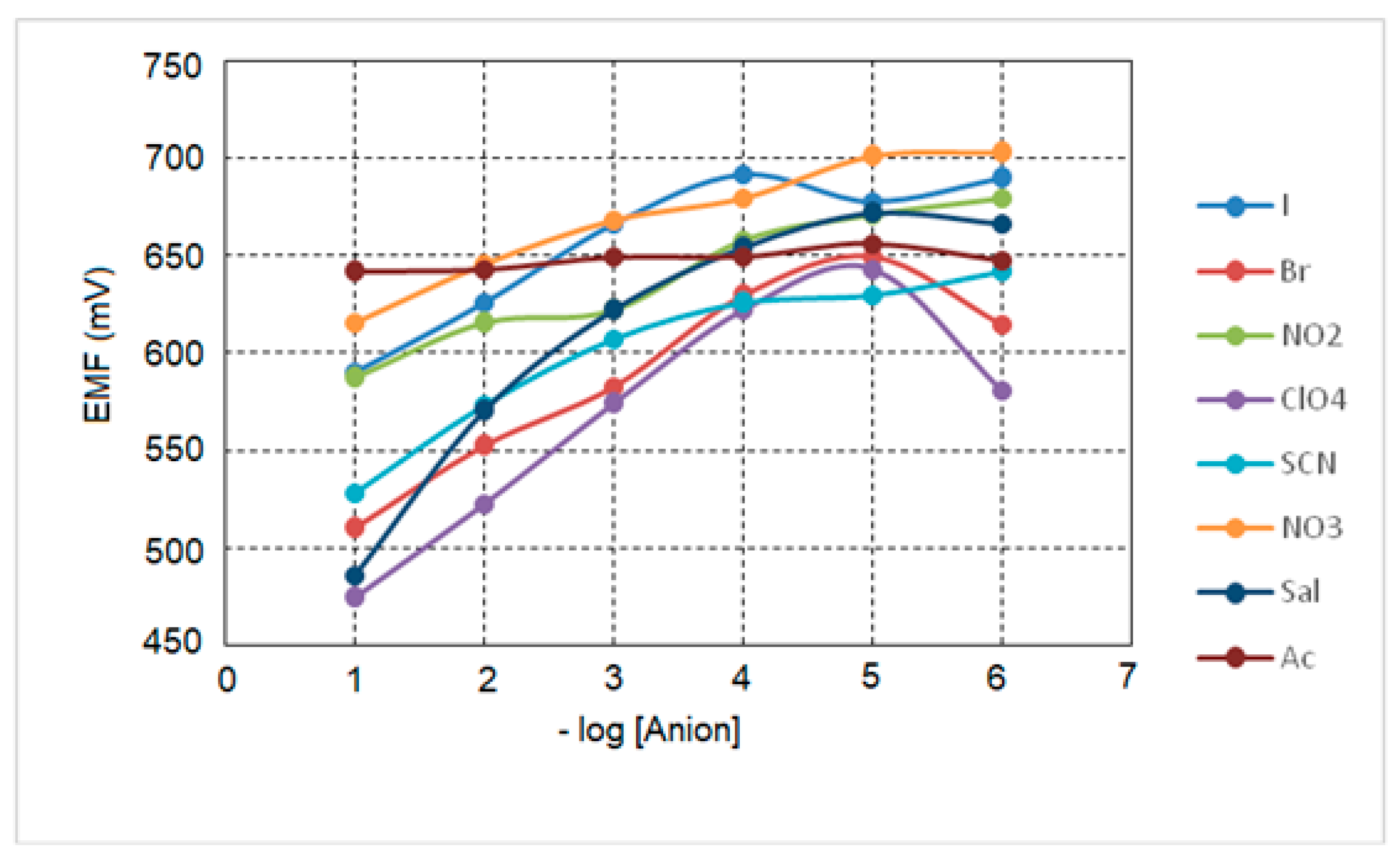

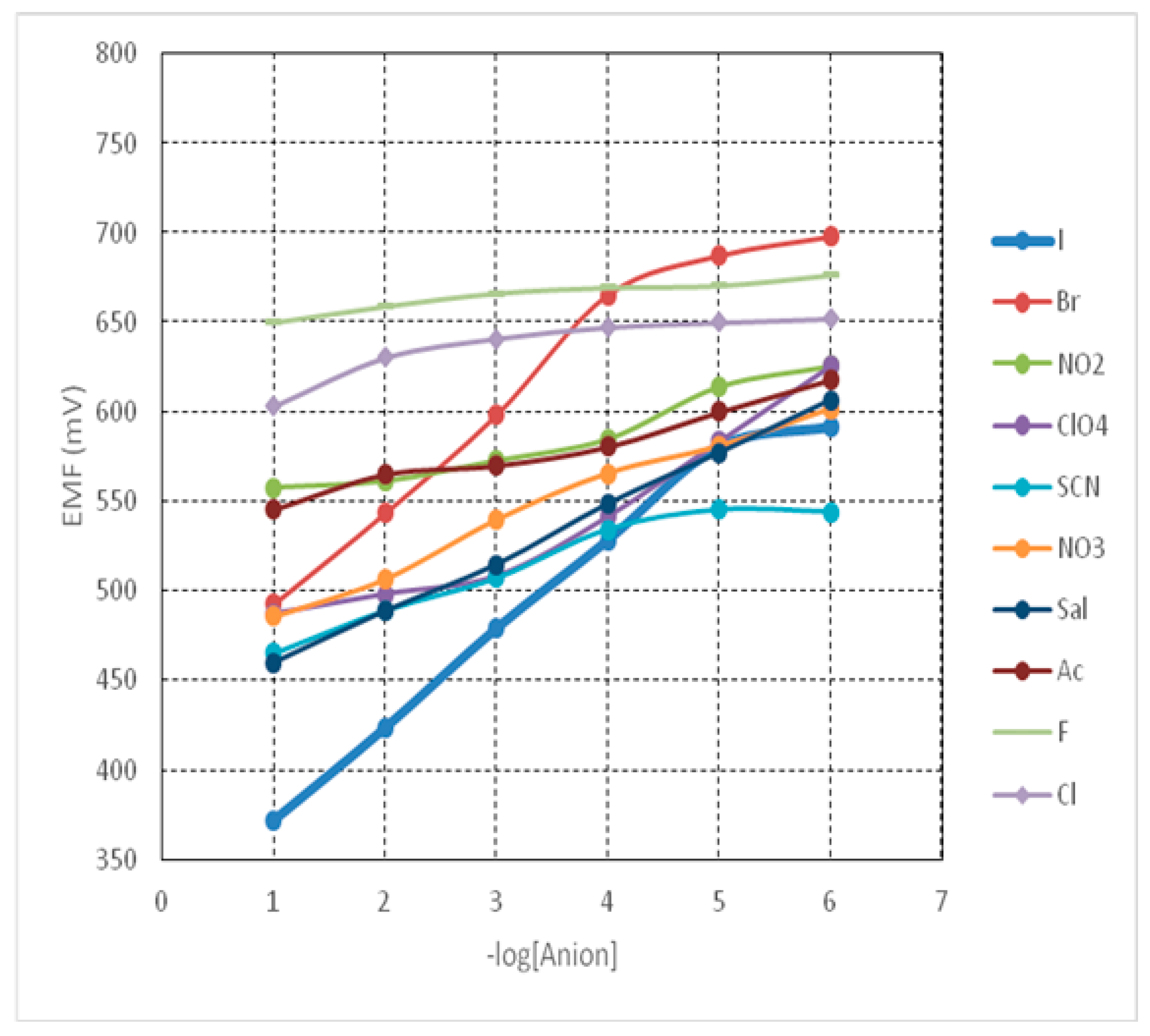
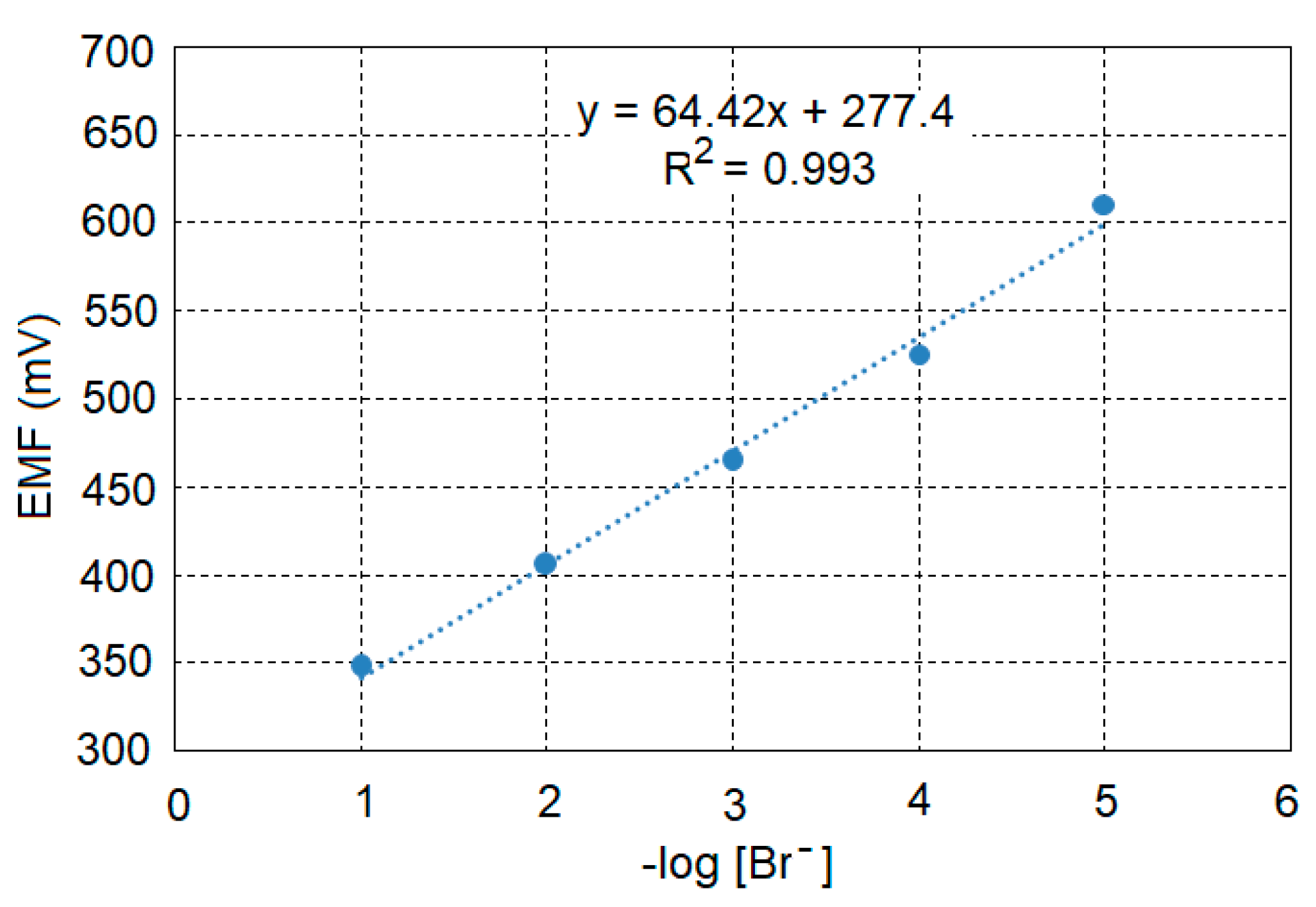

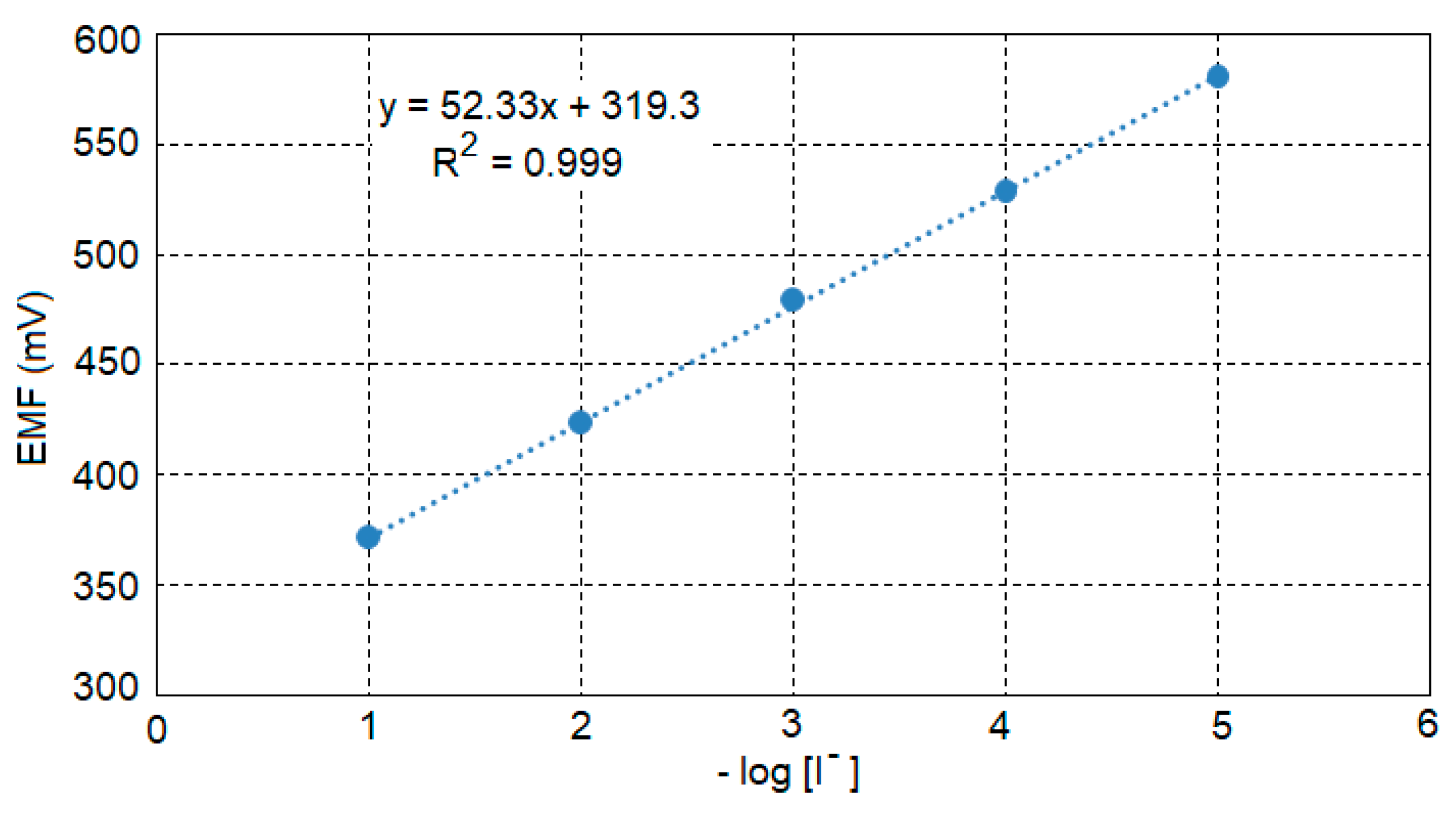
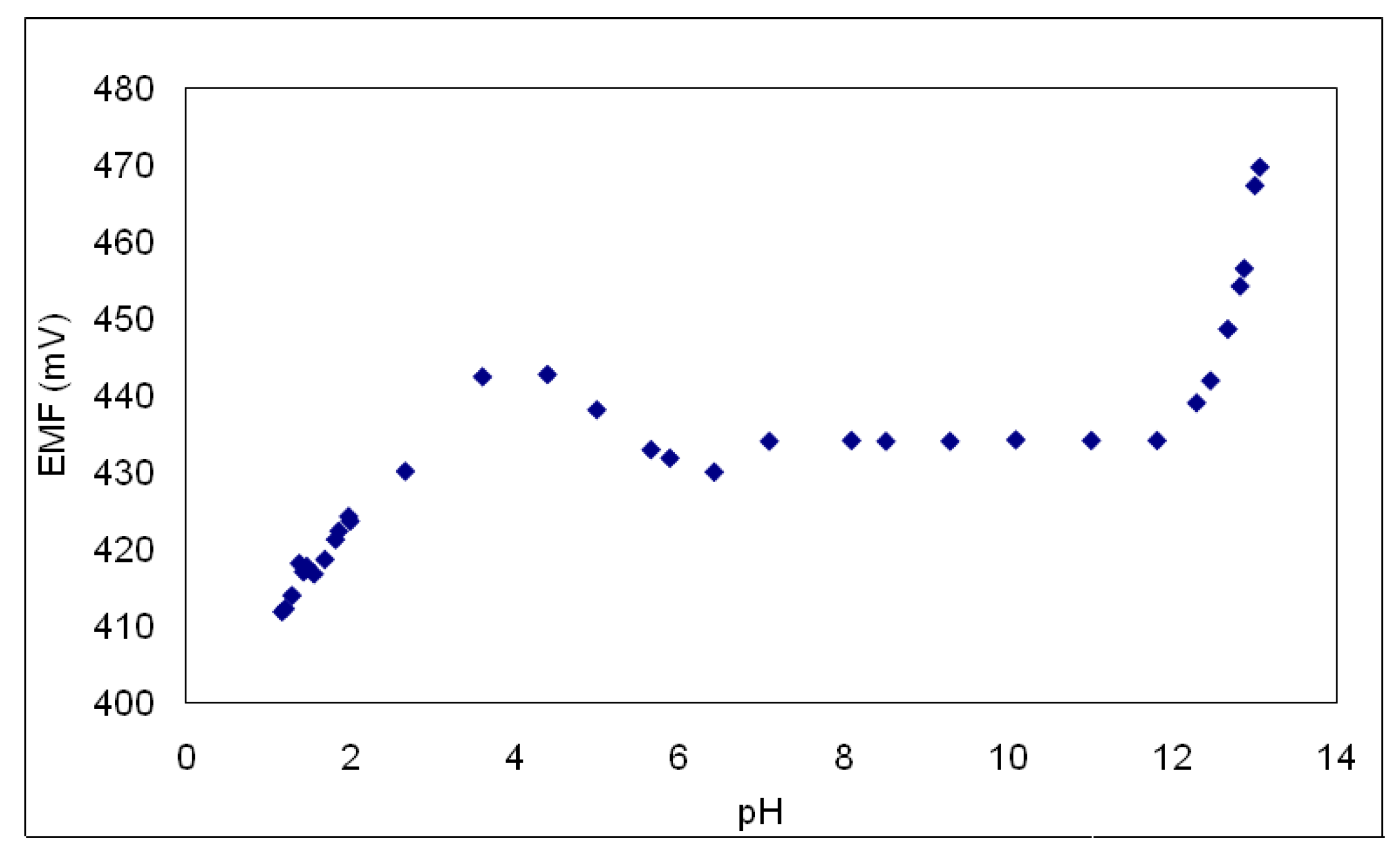
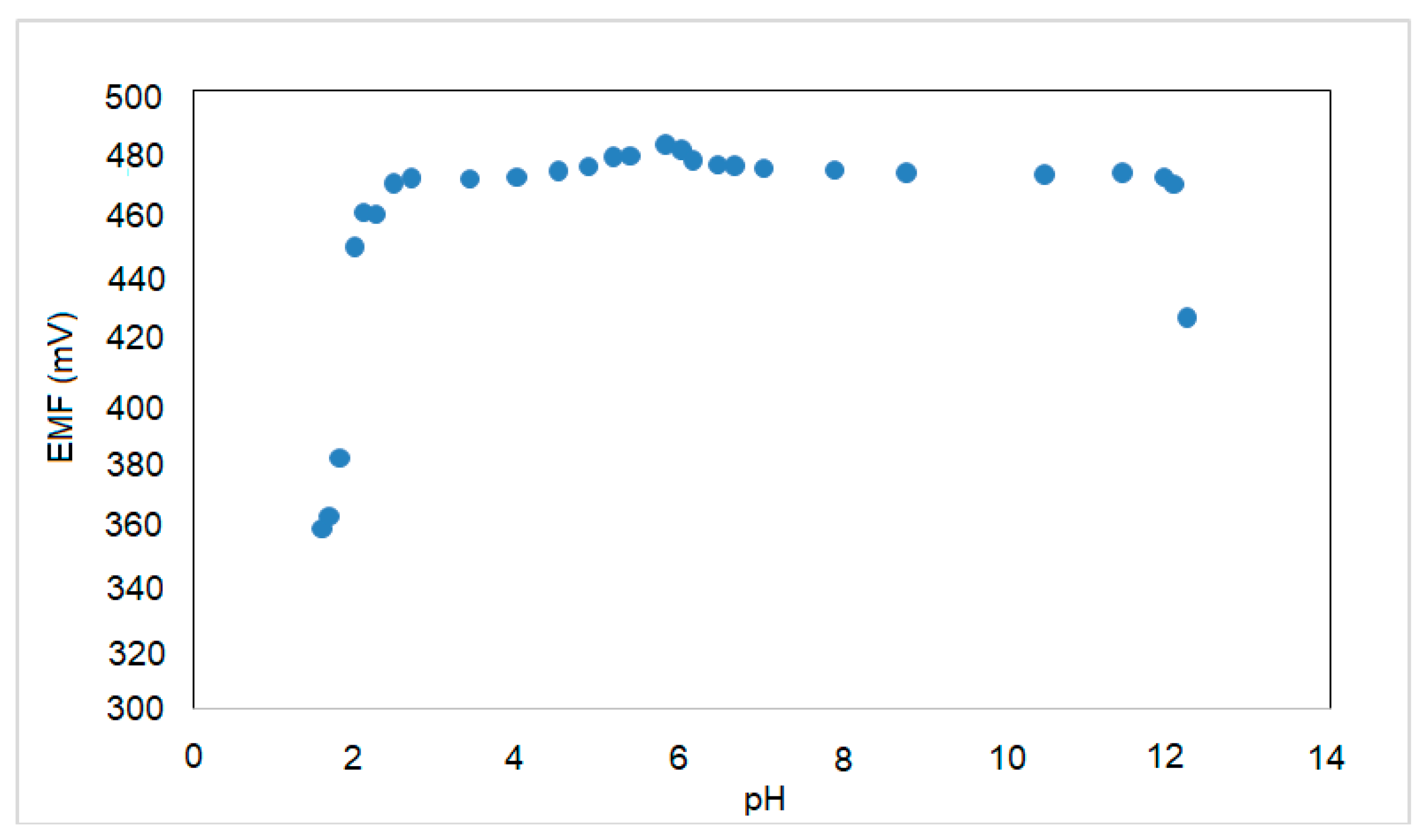
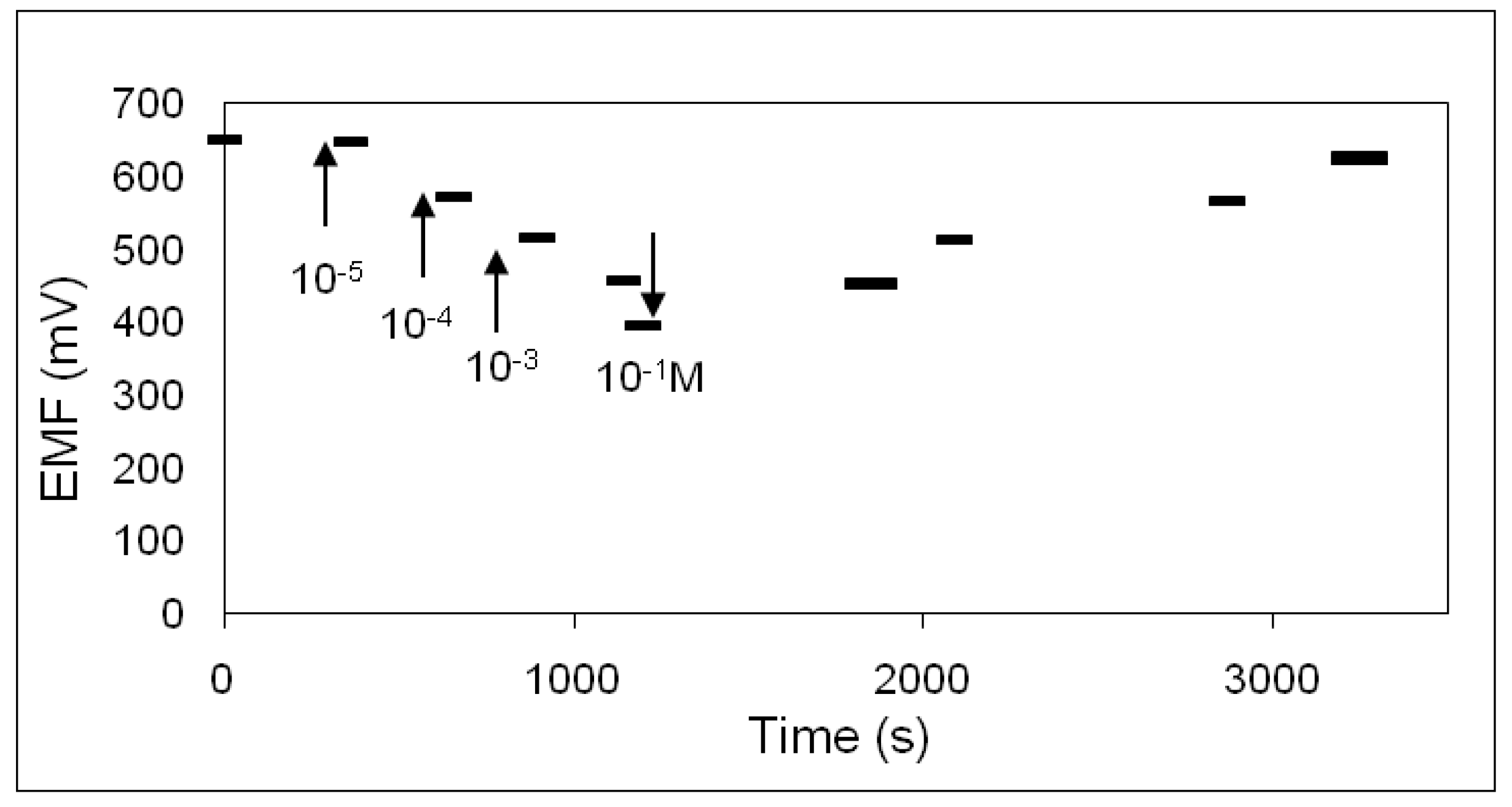

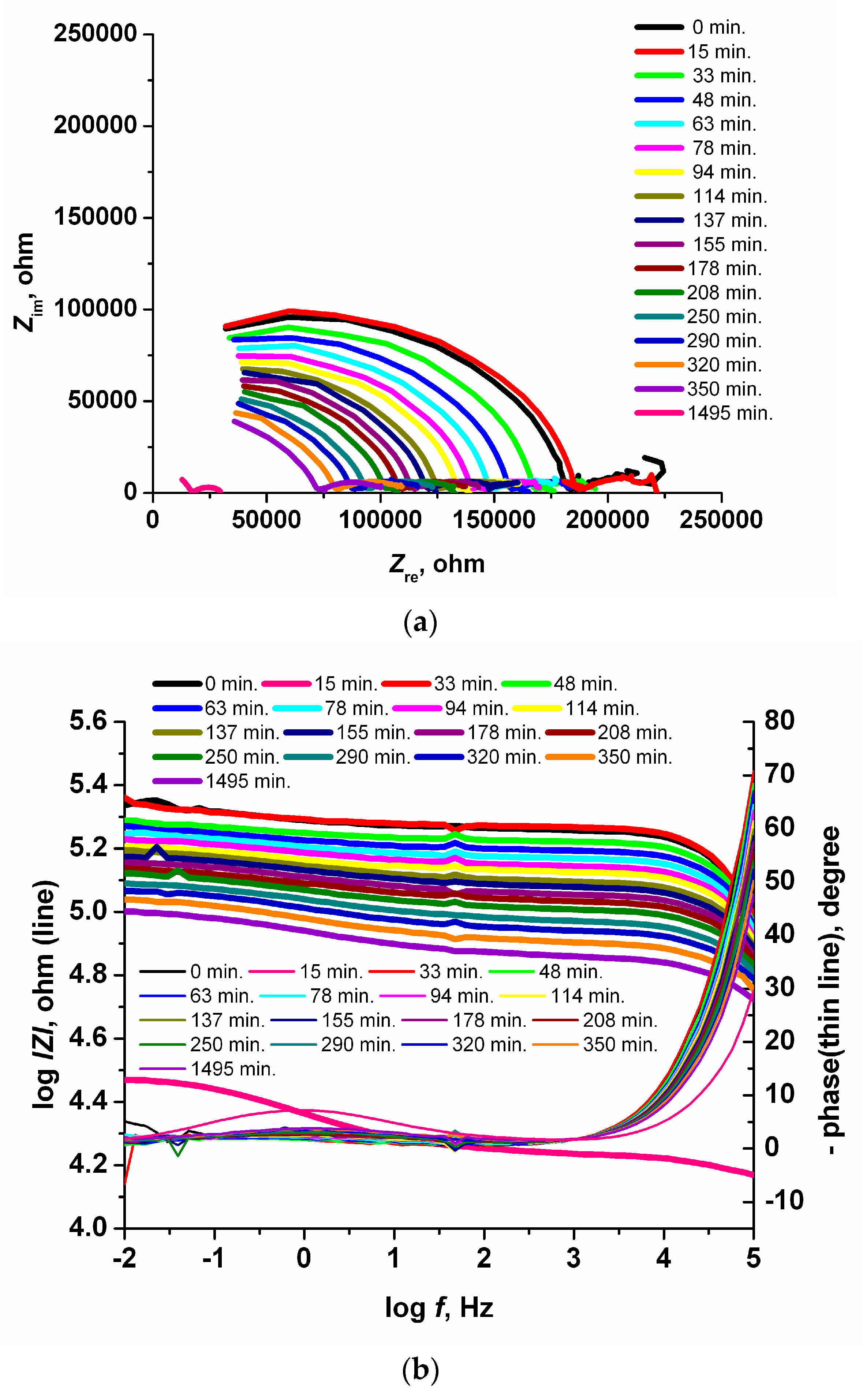


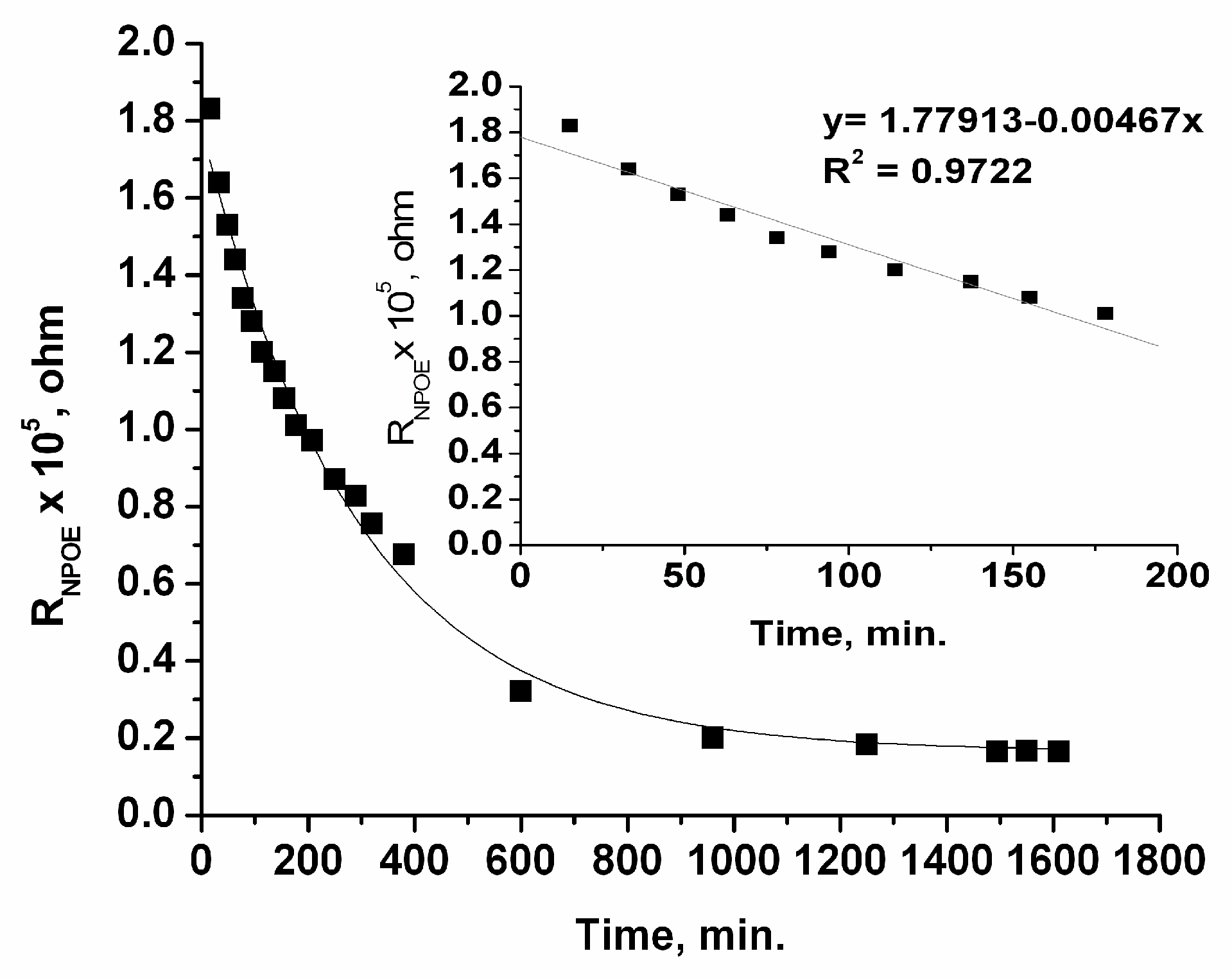

| Sensor | Ionophore | Plasticizer | PVC | ||
|---|---|---|---|---|---|
| DOS | DOP | NPOE | |||
| A | 1 | 66 | 33 | ||
| B | 1 | 66 | 33 | ||
| C | 1 | 66 | 33 | ||
| X− | Br | I | NO2 | ClO4 | SCN | NO3 | Sal | Ac | Cl | F |
|---|---|---|---|---|---|---|---|---|---|---|
| logKBr,X | 0.00 | −1.83 | −1.41 | −0.30 | −0.60 | −1.51 | −0.80 | −3.75 | −3.67 | −4.01 |
| log KI,X | −2.03 | 0.00 | −2.34 | −1.27 | −1.11 | −1.41 | −1.10 | −2.40 | −3.50 | −3.98 |
| Experiment | Time, min | Chi-Sqr | Sum-Sqr | Rs, ohm·cm−2 | C1, F·cm2 | R1, ohm·cm−2 | C2-T, F·cm2 | C2-P, (ф) | R2, ohm·cm−2 |
|---|---|---|---|---|---|---|---|---|---|
| 0 | 0 | 0.004894 | 0.16152 | 0.018 | 1.69 × 10−11 | 1.78 × 105 | 2.91 × 10−5 | 0.2697 | 161,000 |
| 1 | 15 | 0.004599 | 0.15178 | 0.018 | 1.74 × 10−11 | 1.83 × 105 | 2.88 × 10−5 | 0.31686 | 59,954 |
| 2 | 33 | 0.004119 | 0.13592 | 0.011 | 1.73 × 10−11 | 1.64 × 105 | 2.79 × 10−5 | 0.28851 | 47,912 |
| 3 | 48 | 0.004075 | 0.13449 | 0.009 | 1.75 × 10−11 | 1.53 × 105 | 2.34 × 10−5 | 0.29763 | 46,669 |
| 4 | 63 | 0.002594 | 0.08561 | 0.021 | 1.82 × 10−11 | 1.44 × 105 | 2.25 × 10−5 | 0.28722 | 52,919 |
| 5 | 78 | 0.002362 | 0.07795 | 0.019 | 1.85 × 10−11 | 1.34 × 105 | 1.99 × 10−5 | 0.25473 | 59,122 |
| 6 | 94 | 0.002003 | 0.06609 | 0.014 | 1.95 × 10−11 | 1.28 × 105 | 2.45 × 10−5 | 0.23866 | 63,503 |
| 7 | 114 | 0.002141 | 0.07066 | 0.018 | 1.98 × 10−11 | 1.20 × 105 | 1.74 × 10−5 | 0.28806 | 51,832 |
| 8 | 137 | 0.004255 | 0.14040 | 0.018 | 1.98 × 10−11 | 1.15 × 105 | 2.02 × 10−5 | 0.27591 | 69,521 |
| 9 | 155 | 0.002377 | 0.07845 | 0.018 | 2.02 × 10−11 | 1.08 × 105 | 1.70 × 10−5 | 0.27767 | 51,633 |
| 10 | 178 | 0.002051 | 0.06769 | 0.003 | 2.09 × 10−11 | 1.01 × 105 | 1.79 × 10−5 | 0.23961 | 56,215 |
| 11 | 208 | 0.002489 | 0.08213 | 0.018 | 2.10 × 10−11 | 97,137 | 1.62 × 10−5 | 0.29857 | 47,008 |
| 12 | 250 | 0.001946 | 0.06422 | 0.018 | 2.24 × 10−11 | 87,083 | 1.64 × 10−5 | 0.25399 | 54,603 |
| 13 | 290 | 0.001997 | 0.06590 | 0.018 | 2.31 × 10−11 | 82,704 | 1.67 × 10−5 | 0.29825 | 48,680 |
| 14 | 320 | 0.001972 | 0.06506 | 0.018 | 2.41 × 10−11 | 75,544 | 1.59 × 10−5 | 0.30225 | 45,276 |
| 15 | 380 | 0.001752 | 0.05783 | 0.019 | 2.52 × 10−11 | 67,552 | 1.72 × 10−5 | 0.28623 | 45,792 |
| 16 | 1495 | 0.001962 | 0.06476 | 0.019 | 6.00 × 10−11 | 16,596 | 3.98 × 10−5 | 0.43701 | 15,680 |
| Synthetic Sample | Amount (mol/L) | Found by Electrode (mol/L ± S a) |
|---|---|---|
| Iodide | 7.5 × 10−4 | (7.4 ± 0.1) × 10−4 |
| Bromide | 5.0 × 10−4 | (5.2 ± 0.2) × 10−4 |
| Sample | Label Amount (µg) | Found by Potentiometry (µg) |
|---|---|---|
| Potassium iodide tablets (Merck) | 130.8 | 129.7 ± 0.9 |
© 2018 by the authors. Licensee MDPI, Basel, Switzerland. This article is an open access article distributed under the terms and conditions of the Creative Commons Attribution (CC BY) license (http://creativecommons.org/licenses/by/4.0/).
Share and Cite
Vlascici, D.; Plesu, N.; Fagadar-Cosma, G.; Lascu, A.; Petric, M.; Crisan, M.; Belean, A.; Fagadar-Cosma, E. Potentiometric Sensors for Iodide and Bromide Based on Pt(II)-Porphyrin. Sensors 2018, 18, 2297. https://doi.org/10.3390/s18072297
Vlascici D, Plesu N, Fagadar-Cosma G, Lascu A, Petric M, Crisan M, Belean A, Fagadar-Cosma E. Potentiometric Sensors for Iodide and Bromide Based on Pt(II)-Porphyrin. Sensors. 2018; 18(7):2297. https://doi.org/10.3390/s18072297
Chicago/Turabian StyleVlascici, Dana, Nicoleta Plesu, Gheorghe Fagadar-Cosma, Anca Lascu, Mihaela Petric, Manuela Crisan, Anca Belean, and Eugenia Fagadar-Cosma. 2018. "Potentiometric Sensors for Iodide and Bromide Based on Pt(II)-Porphyrin" Sensors 18, no. 7: 2297. https://doi.org/10.3390/s18072297
APA StyleVlascici, D., Plesu, N., Fagadar-Cosma, G., Lascu, A., Petric, M., Crisan, M., Belean, A., & Fagadar-Cosma, E. (2018). Potentiometric Sensors for Iodide and Bromide Based on Pt(II)-Porphyrin. Sensors, 18(7), 2297. https://doi.org/10.3390/s18072297








